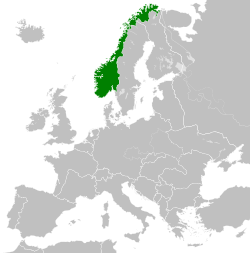National Government Den nasjonale regjering | |||||||||
|---|---|---|---|---|---|---|---|---|---|
| 1942–1945 | |||||||||
| Anthem: Ja, vi elsker dette landet (English: "Yes, we love this country") [1] | |||||||||
 | |||||||||
| Status | Puppet state in German-occupied Norway | ||||||||
| Capital | Oslo | ||||||||
| Common languages | Norwegian | ||||||||
| Religion | Lutheranism | ||||||||
| Government | Nazi one-party fascist state under a totalitarian duumvirate | ||||||||
| Reichskommissar | |||||||||
• 1940–1945 | Josef Terboven | ||||||||
• 1945 | Franz Böhme (acting) | ||||||||
| Minister President | |||||||||
• 1942–1945 | Vidkun Quisling | ||||||||
| Historical era | World War II | ||||||||
• Proclamation | 1 February 1942 | ||||||||
• German capitulation | 8 May 1945 | ||||||||
| Currency | Norwegian krone (NOK) | ||||||||
| |||||||||
| Today part of | Norway | ||||||||
The Quisling regime, or Quisling government are common names used to refer to the fascist collaboration government led by Vidkun Quisling in German-occupied Norway during the Second World War.[2][3][4] The official name of the regime from 1 February 1942 until its dissolution in May 1945 was Den nasjonale regjering (English: the National Government).[2] Actual executive power was retained by the Reichskommissariat Norwegen, headed by Josef Terboven.
- ^ "Nasjonalbiblioteket".
- ^ a b Dahl, Hans Fredrik (1995). "nasjonale regjering". In Hans Fredrik Dahl (ed.). Norsk krigsleksikon 1940-45 (in Norwegian). Oslo: Cappelen. pp. 285–286. ISBN 82-02-14138-9.
- ^ "Inndragning av jødisk eiendom i Norge under den 2. verdenskrig". Government of Norway (in Norwegian). 19 June 1997. Retrieved 2009-09-17.
- ^ Tønnesson, Johan L. (1 February 2000). "Prosjektarbeidet: Bygg et "Norge"". Apollon (in Norwegian). Archived from the original on 19 July 2011. Retrieved 2009-09-03.

